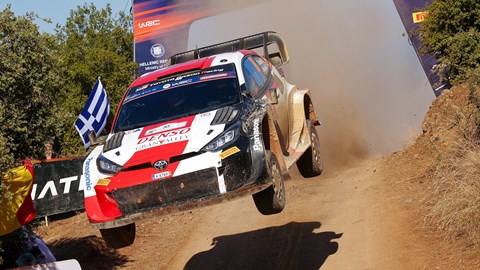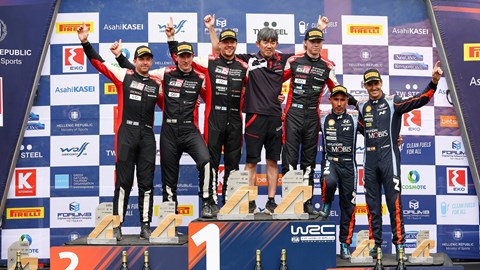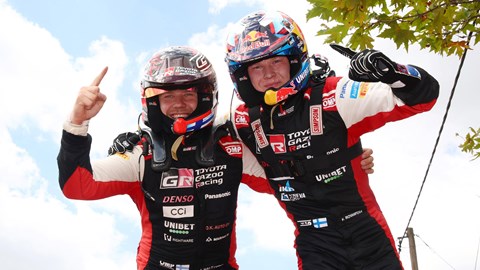► 48 hours with Toyota WRC rally team
► At the arduous Acropolis Rally
► Toyota takes an eventful 1-2
It’s around 9 o’clock on Saturday when the stricken Toyota GR Yaris of eight-time world champion Sébastien Ogier returns to the service park. Covered in a fine layer of dust – typical of this rally – and strapped to the back of a flatbed truck, it looks relatively fine from the front, but a look around the car reveals a destroyed left rear suspension.
The damage occurred on stage 9, and although Ogier managed to skip to the end of the stage, he couldn’t make it to the service park. It’s an injury typical of the Acropolis Rally – known as a car-breaker amongst the WRC teams – and it’s the beginning of the end for the Frenchman’s chances.
For the past 24 hours we’ve watched the Toyota team try to solidify its commanding lead in the drivers’ and constructors’ championship – but nothing is simple in the Acropolis Rally. It’s fair to say rallying is a tough sport on driver and machine, but somehow this event manages to set itself apart. Situated on the dusty, rocky roads of Lamia and Athens, it takes in miles of seriously challenging mountain roads – all in the pounding heat of the Greek summer.
The Acropolis Rally
‘Historically Acropolis is one of the hard rallies,’ Toyota’s technical director Tom Fowler tells CAR. ‘Of course, there’s the roughness of the roads, and included in that it’s just how hard the roads are. So in rallying terms, we talk about roads being made from bedrock. A lot of the stones they’re driving over on are completely immovable.’
It’s a fact we contend with firsthand just hours earlier: extreme rains the week before have washed away the top layer of earth from sections of path, revealing unforgiving rock. The Acropolis Rally doesn’t so much take place on gravel roads, but on the tectonic plates themselves.
The prehistoric terrain has implications for the cars. ‘This is very challenging for the car technically, for the strength of the car, but also for the tyres,’ Fowler tells us. WRC cars are solid things, but they’re tested here in a whole new way. In order to account for the hard surface, engineers preload the highest suspension travel this side of a moon buggy; cars lean back at the start line, nose-dive in braking zones and jump over crests like a carbonfibre daddy long legs. But there are still failures.

Just hours before, both Toyota’s Sébastien Ogier and Hyundai’s Thierry Neuville encounter problems, with Brit and Toyota driver Elfyn Evans limping past us earlier on with an overheating issue. In most situations these cars would be bulletproof, but here WRC cars feel considerably more mortal.
Tyres seem to be a dominating factor in every form of motorsport, and they’re equally important here. Each driver has just 28 to use throughout the event, with spares carried onboard. As you’d expect, drivers get through tyres here from degradation as well as punctures – and again like F1, tyre strategy often plays a key part in victory. ‘We need to get there as quickly as possible, but as reliably as possible,’ says Fowler. ‘And this is one of the biggest difficulties.’
Welcome to the service park
Rallying has always been about fighting the elements as well as other competitors – but the whole thing feels even more brutal in the service parks. Essentially a pit area and motorhome complex combined, it’s in these areas the teams make repairs to their cars before sending them out to the mountains again. However, this turns out to be more than a simple patch-up; over the course of around 30 minutes each Toyota GR Yaris Rally1 is gutted to the tub and rebuilt.
Toyota runs four cars, and each of them have their own service bay. The arrival time of each car is estimated on a monitor (think McDonalds delivery queue screen and you’re pretty much there) and in the meantime engineers prepare the bay for the incoming car. It’s a slow rush: required parts for each corner are laid out in advance, while incredibly organised toolboxes (one per corner) lie in wait. Simply put, it’s like having a dentist’s tray for each side of the car.
When the first of the Toyotas finally arrives, what follows has all the intensity and organisation of a Formula One pitstop, only for around half an hour. It’s organised chaos: precise yet violent. Each team of mechanics descend on the car as soon as they can with a flurry of hammers, ratchets and welders. At the same time, a technician walks over with a laptop, ready to manually download telemetry and run diagnostics (over-the-air telemetry isn’t allowed in WRC yet).
Despite watching it in real time with my own eyes, the speed at which the car is stripped feels unreal – as if on a timelapse. As the minutes tick by, it’s possible to see more of the car’s structure as tired dampers and cracked bodywork get removed and taken to the disassembly tent. In seconds new components are slotted into place, ready to be battered and pummelled by the next stage.
Only six mechanics are allowed to touch the car, so other mechanics take away parts and hand over tools, like a motorsport version of Japanese Kuroko. Bits of Acropolis Rally occasionally spill on to the ground as other parts are removed, and they’re tidied away with a dustpan and brush. All the old parts eventually make their way to a disassembly tent, ready to be studied and reconditioned.

This process is standard practice for every team taking part, but it’s extraordinary for this writer to witness. Like a boxer going to their corner between rounds, these service parks feel like a sliver of respite for the cars and drivers, as they wait to get beaten up all over again. It’s drive to survive in its truest form.
How is Toyota doing in the WRC?
This year’s championship is being dominated by the Japanese brand, with the fight for the title between 22-year-old defending champion Kalle Rovanperä and his teammate Elfyn Evans. Toyota also employs eight-time world champion Sébastien Ogier – though he only sits fifth in the championship at the time of writing. The team’s final driver is Takamoto Katsuta, who is currently seventh in the standings.
According to technical director Tom Fowler, the reason for the team’s dominance is two-fold: ‘We feel that we come to events very well prepared,’ he says. ‘We don’t come with one strategy, and we are prepared to change our strategy as we go.’

Secondly, Toyota has an advantage on the powertrain side – not in sheer power, but dynamics and driveability. Now into its third year, hybrid power has come with its own unique set of challenges, and the Toyota appears to have mastered them first.
‘Formerly, the internal combustion engine was located in the front [and there was] no powertrain in the rear except the mechanical drivetrain, with the propshaft and rear differential,’ Fowler tells us.
‘Now, the hybrid portion of the drivetrain is situated in the rear of the car. We have a battery and the MGU and also the electronics associated in the rear of the car, which is approximately 90kg.’

Getting the drivers happier with a more rearward weight distribution has been crucial to Toyota’s success in the hybrid era, but the driveability and predictability of the hybrid powertrain is the other key area Toyota’s bods seem to have nailed.
‘The hybrid system is not available 100% of the time. So what you have is a car which has 400 horsepower all of the time, and has 500 horsepower some of the time,’ Fowler explains. ‘We have to make sure that it is predictable some of the time.
‘We feel that we’re really on top of it, particularly compared to our competitors, and this gave us an advantage certainly last season. I think we were really quick to be good at hybrid compared to the others and maybe they are catching up with us at the moment.’
How easy is it to spectate at the WRC?
As the last functioning Toyota pulls out of the service park, it’s a good time to reflect on the rallying action we’ve seen so far – because there hasn’t been that much. Watching a rally involves trying to intercept the cars at key stages, whilst also contending with the elements and traffic yourself. Forget grandstands, food trucks or toilets, watching a rally is about finding the most comfortable rock you can, bringing your own snacks – and usually finding the most exclusive bush. In total, we’ve seen under an hour of Rally1 action, and driven for about three hours to see it. But what an hour it’s been.
Having waited for hours and performed D of E levels of hiking, there’s massive anticipation by the time the top cars do go past – and when they do there’s a level of immediacy and energy that only rallying can provide. The driving here is about surviving in the quickest possible time, and the urgency and difficulty involved really comes across when you’re just metres away from the action.
The difference in driving styles is immediately obvious; but every car is visceral to watch. You only ever get to see a 10-second snapshot of the overall stage, but it’s almost worth it.
As we leave for home, news comes through of Toyota’s victory at the rally. Defending champion Kalle Rovanperä has taken victory 1min 31.7sec ahead of teammate Elfyn Evans. The championship leader just one of two Rally1 cars that completed the event without experiencing an issue. The Acropolis Rally has lived up to its reputation once again.
Later, news of Toyota’s victory in the WEC race in Fuji also comes through – and it’s interesting to compare the two bookends of the brand’s motorsport activities. Rallying might use hybrid technology like the F1 and the WEC, but it still has gritty grassroots feel that the other two formula lost decades ago. Which do I prefer? They’re both equally entertaining to watch on TV – though one is significantly easier to spectate in person.